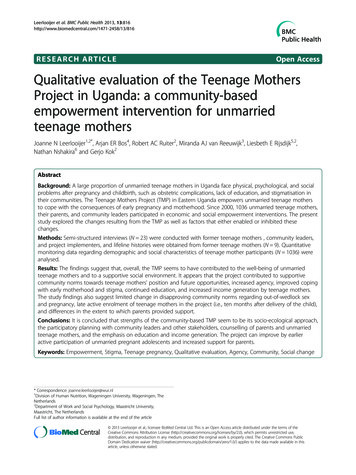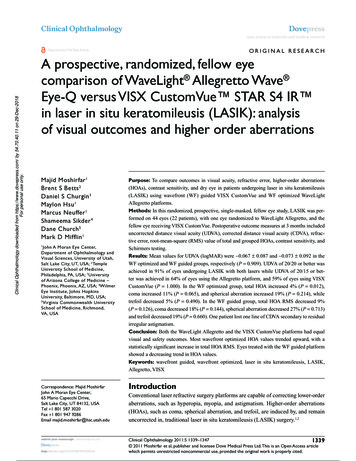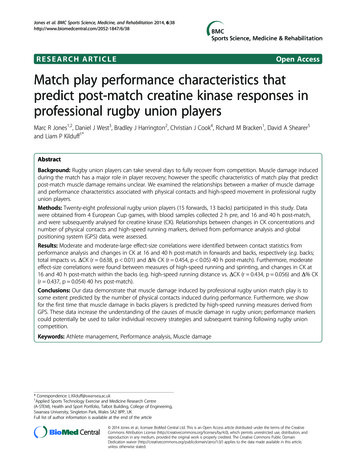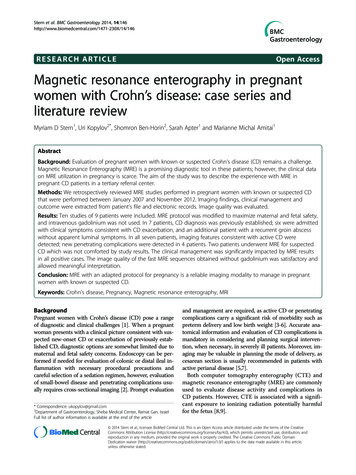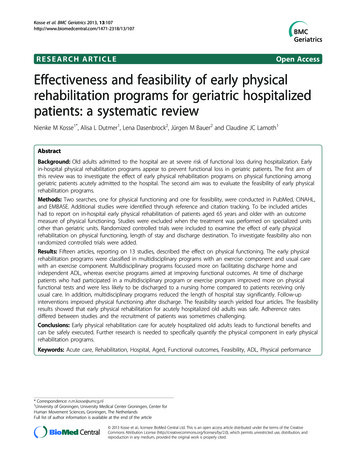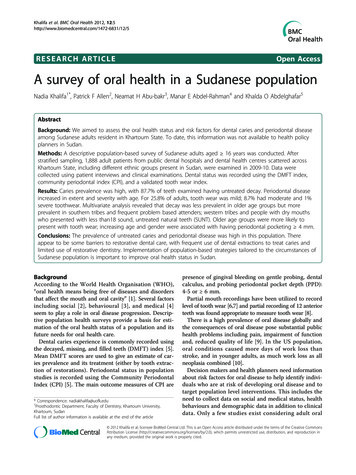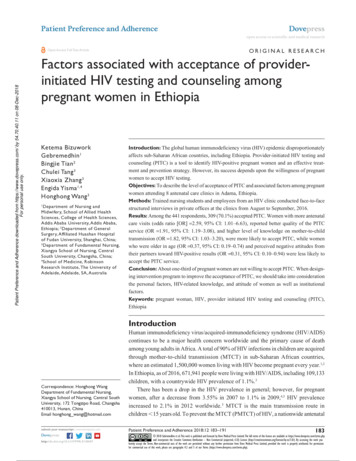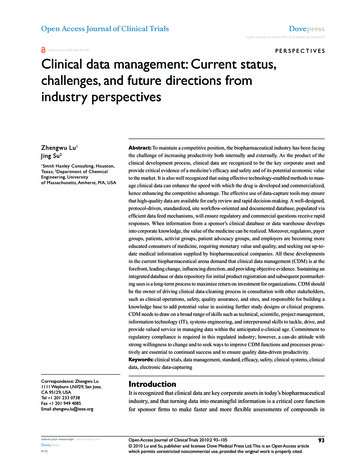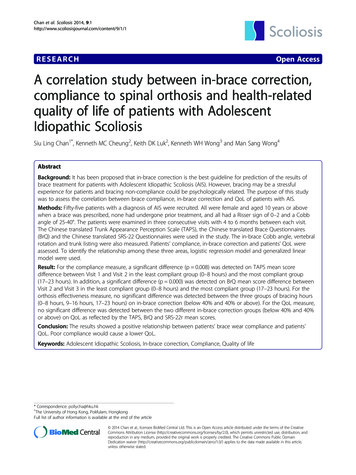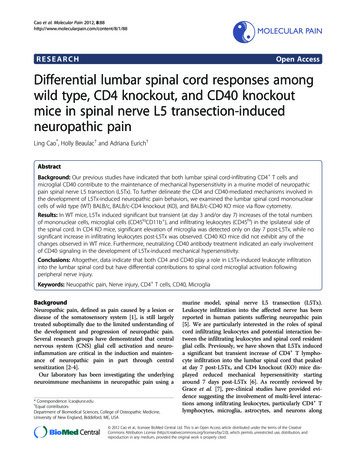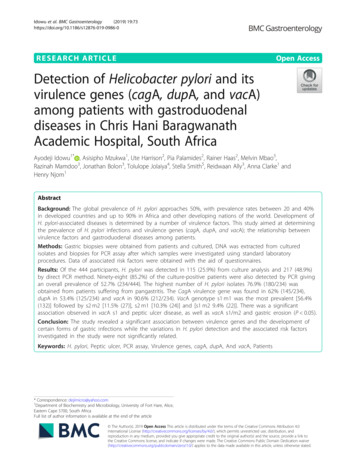
Transcription
Idowu et al. BMC Gastroenterology(2019) ARCH ARTICLEOpen AccessDetection of Helicobacter pylori and itsvirulence genes (cagA, dupA, and vacA)among patients with gastroduodenaldiseases in Chris Hani BaragwanathAcademic Hospital, South AfricaAyodeji Idowu1* , Asisipho Mzukwa1, Ute Harrison2, Pia Palamides2, Rainer Haas2, Melvin Mbao3,Razinah Mamdoo3, Jonathan Bolon3, Tolulope Jolaiya4, Stella Smith5, Reidwaan Ally3, Anna Clarke1 andHenry Njom1AbstractBackground: The global prevalence of H. pylori approaches 50%, with prevalence rates between 20 and 40%in developed countries and up to 90% in Africa and other developing nations of the world. Development ofH. pylori-associated diseases is determined by a number of virulence factors. This study aimed at determiningthe prevalence of H. pylori infections and virulence genes (cagA, dupA, and vacA); the relationship betweenvirulence factors and gastroduodenal diseases among patients.Methods: Gastric biopsies were obtained from patients and cultured, DNA was extracted from culturedisolates and biopsies for PCR assay after which samples were investigated using standard laboratoryprocedures. Data of associated risk factors were obtained with the aid of questionnaires.Results: Of the 444 participants, H. pylori was detected in 115 (25.9%) from culture analysis and 217 (48.9%)by direct PCR method. Ninety-eight (85.2%) of the culture-positive patients were also detected by PCR givingan overall prevalence of 52.7% (234/444). The highest number of H. pylori isolates 76.9% (180/234) wasobtained from patients suffering from pangastritis. The CagA virulence gene was found in 62% (145/234),dupA in 53.4% (125/234) and vacA in 90.6% (212/234). VacA genotype s1 m1 was the most prevalent [56.4%(132)] followed by s2 m2 [11.5% (27)], s2 m1 [10.3% (24)] and [s1 m2 9.4% (22)]. There was a significantassociation observed in vacA s1 and peptic ulcer disease, as well as vacA s1/m2 and gastric erosion (P 0.05).Conclusion: The study revealed a significant association between virulence genes and the development ofcertain forms of gastric infections while the variations in H. pylori detection and the associated risk factorsinvestigated in the study were not significantly related.Keywords: H. pylori, Peptic ulcer, PCR assay, Virulence genes, cagA, dupA, And vacA, Patients* Correspondence: dejimicro@yahoo.com1Department of Biochemistry and Microbiology, University of Fort Hare, Alice,Eastern Cape 5700, South AfricaFull list of author information is available at the end of the article The Author(s). 2019 Open Access This article is distributed under the terms of the Creative Commons Attribution 4.0International License (http://creativecommons.org/licenses/by/4.0/), which permits unrestricted use, distribution, andreproduction in any medium, provided you give appropriate credit to the original author(s) and the source, provide a link tothe Creative Commons license, and indicate if changes were made. The Creative Commons Public Domain Dedication o/1.0/) applies to the data made available in this article, unless otherwise stated.
Idowu et al. BMC Gastroenterology(2019) 19:73BackgroundThe global prevalence of H. pylori approaches 50%(approximately 4.4 billion individuals infected), withprevalence rates between 20 and 40% in developedcountries and up to 90% in Africa and other developingnations of the world [1]. The prevalence of infectiondiffers among the population of people and withincountries in relation to race, ethnicity, and geographicallocation [2]. In South Africa, the high prevalence of infection with the pathogen is common in children andadults [3]. A prevalence of 87% was reported in theEastern Cape among asymptomatic individuals [4]. Furthermore, the prevalence of 13.5 to 84.2% was reportedin pediatric subjects of Bloemfontein, 66% in blackchildren of KwaZulu/Natal, and 50.6% in Thohoyandou[5]. Variations in the prevalence rates have been attributed to factors such as low socio-economic conditions,poor hygiene, and overcrowding in residences [4].Though mode of transmission is still unclear, manyauthors have suggested fecal-oral routes via contaminated water, food and unwashed hands [6, 7]. Thesmoking of cigarette, alcohol consumption, diet, occupational exposure, individual genetic trait have beendemonstrated as risk factors associated with infection ofH. pylori [8]. However, oftentimes the results are inconsistent, with some studies indicating no difference inprevalence compared to a control group [9], while othersdisplay a lower or a higher prevalence [10, 11].Several diagnostic methods (both invasive andnon-invasive) have been described to detect H. pyloriinfection for epidemiological studies [12]. In the currentstudy, we used a culture method and polymerase chainreaction (PCR) assay to isolate and detect or confirm H.pylori respectively. The two diagnostic methods havebeen reported to be specific and sensitive while onseveral occasions regarded as gold standards [13]. However, due to the long duration of incubation and falsenegative results, the culture method is usually avoided.Some studies have embraced a seroprevalence approach,which detects the antibodies but is unable to differentiate passive and active infection.On the basis of disease progression, development ofailment depends on bacteria strain, host body, andenvironmental factors. Induction and progression of H.pylori-associated diseases are determined by a numberof virulence factors [14]. Among them, the cytotoxin-associated gene A (cagA), vacuolating cytotoxin gene A(vacA) and duodenal ulcer promoting gene A (dupA)virulence markers have been widely studied [15]. ThecagA has been described as the first bacterial oncoprotein and probably the virulence factor with the mostimportant potential of H. pylori [16] while vacA toxinplays a significant role in immune modulation as well asin the induction of gastric cancer [17]. Selection ofPage 2 of 10virulence markers is vital when using them to determinethe risk of diseases. For instance, the cagA, dupA andvacA genes have been considered important virulencefactors in relation to gastroduodenal diseases both inchildren and adults in Brazil [18]. Furthermore, cagAand vacA genotypes have been implicated with gastricdiseases in Pakistan [24]. Similarly, development of aduodenal ulcer in a South East Indian Population wasseen as a result of the presence of dupA in H. pylori[20]. Elsewhere in Iran, infection with H. pylori dupAnegative strains was associated with high risk of development of stomach ulcer and cancer [21].In Soweto, South Africa, existing data on the subjectare few [22]. Thus, there is a need for a recent study toprovide information on H. pylori virulence factors andtheir roles in the development of gastroduodenal diseases. Therefore, this study was aimed at determiningthe prevalence of H. pylori, detect the presence of cagA,vacA and dupA virulence genes in patients at Chris HaniBaragwanath Academic Hospital and to analyze therelationship between these virulence genes and gastroduodenal disease development. The study also investigated the risk factors associated with gastroduodenaldiseases among participants.MethodsPatient recruitmentPatients were recruited in the gastrointestinal tract(GIT) unit of the Chris Hani Baragwanath AcademicHospital (CHBAH) between August 2017 and February2018. Only those who gave consent were enrolled. Thestudy included those with stomach affliction and referred for a non-sedated upper gastrointestinal endoscopy excluding patients recently on antibiotics and othereradication therapies in the last 3 months. Researchquestionnaires [Additional file 1] were administered tovolunteered participants. The hospital (CHBAH) is apublic health institution located in the Soweto area ofJohannesburg (GPS coordinates 26.2612oS, 27.9426 E). Itis known as the third largest hospital in the world withapproximately 3200 beds. The hospital has a well functional GIT clinic which enrolls the highest number ofpatients in the country (over 2000 procedures annually).It is run by the Gauteng Provincial Health Authority andalso a Teaching Hospital affiliated to the Medical Schoolof The University of the Witwatersrand.Collection of biopsiesA consultant gastroenterologist performed the endoscopy. Patients with different gastroduodenal relatedpathologies were sampled. Gastric biopsies were obtained from antrum and corpus of the stomach usingjumbo forceps (Boston Scientific South Africa (Pty) Ltd.)
Idowu et al. BMC Gastroenterology(2019) 19:73and transferred into vials containing portagerm pylori[23] and cultured within 4 h after collection.Isolation of H. pyloriBiopsy specimens were aseptically rolled over the surfaceof Columbia blood agar base plates under a biologicalsafety cabinet (Thermo Scientific). The agar (OxoidCM0331) was supplemented with 7% horse serum(Oxoid SR0048), 1% vitamin mix (Isovitalex), and an H.pylori selective supplement (Dent, SR0147E Oxoid)comprising of amphotericin B (2.5 mg), trimethoprim(2.5 mg), vancomycin (5.0 mg), and cefsulodin (2.5 mg).The plates were incubated at 37 C in an atmosphere of85% N2, 10% CO2 and 5% O2 for 4–10 days. PresumptiveH. pylori colonies were identified as small, round, translucent, Gram-negative and positive for catalase, oxidaseand urease tests. The confirmed isolates were Frozen inbrain heart infusion broth (BHI) containing 20% glyceroland stored at 80 C for future use.DNA extractionTotal genomic DNA was extracted from biopsy tissuesand cultured isolates using a commercial kit (QIAampDNA Mini Kit; Qiagen, Hilden, Germany), according tothe manufacturer’s instructions. Briefly, biopsies werelysed in 180 μl of ATL buffer and 20 μl of proteinase Kat 56 C for overnight incubation. Two hundred microliter of AL buffer was added to the lysate and sampleswere incubated for 10 min at 70 C. After the addition of200 μl absolute ethanol, lysates were purified over aQIAamp column as specified by the manufacturer. Thecolumn was washed stepwisely with 500 μl buffer AW1and buffer AW2, after which an ultra-pure DNA productwas eluted for PCR assay.Molecular confirmation of H. pyloriPCR was performed on extracted DNA from biopsiesusing primers specific for H. pylori 16S rRNA under thefollowing conditions: Initial denaturation of 95 C for 5mins and 35 cycles of 95 C for 30 s, 54 C for 30 s and72 C for 30 s and a final extension time of 72 C for 10Page 3 of 10min. The PCR amplification was performed using a thermocycler system (Bio-Rad Thermal cycler, Singapore).Each 25 μl PCR reaction mixture contained 12.5 μl PCRmaster mix (Promega, GoTag Green Master Mix, USA),0.5 μl each of primer (Metabion, Planegg, Germany), 5 μlof template DNA and 6.5 μl of PCR grade water. Foreach PCR experiment, appropriate positive and negativecontrols were included. The H. pylori strain J99 andnuclease-free water were used as positive and negativecontrols respectively. To detect the amplified product,5 μl of amplicons was visualized by electrophoresisthrough a 1.5% agarose gel (Merck, SA) at 100 V for 40min in 1X TAE buffer and stained with ethidium bromide (500 ng/ml) (Sigma-Aldrich, USA) using the geldocumentation system (Alliance 4.7, France). Identification of the bands was established by comparison of theband sizes with molecular weight markers of 100-bp(Thermo Scientific, (EU) Lithuania). Samples wereconsidered positive when the visible band was the samesize as that of the positive control DNA. The primer for110 bp product of the 16SrRNA sequence representedby the forward primer sequence: 5′-CTGGAGAGACTAAGCCCTCC-3′ and the reverse one: 5′-ATTACTGACGCTGATTGTGC-3′ [24].Detection of virulence genesVirulence genes cagA, dupA and vacA (subtypes: s1, s2,m1, and m2) were detected using PCR specific primers(Table 1) with the same amplification conditions andassay protocol as earlier described.Statistical analysisData were analyzed by a two by two table statisticsand chi-square test to determine the association betweenH. pylori positivity and epidemiological risk factors, aswell as virulence factors and gastroduodenal diseasediagnosis using the SPSS statistical software packageversion 18.0 (SPSS, Inc., Chicago, IL) and OpenSource Epidemiology Statistics for Public HealthTable 1 Primer sequences for PCR detection of virulence genesTarget genePrimer pair (5′-3′)Amplicon length (bp)Control strainsReferencescagAF: ACCGCTCGAGAACCCTAGTCGGTAATGGGR: s1/S2F: ATGGAAATACAACAAACACACR: CTGCTTGAATGCGCCAAAC259/286J99/Tx30avacAm1F: GGTCAAAATGCGGTCATGGR: CCATTGGTACCTGTAGAAAC290J99vacAm2F: CATAACTAGCGCCTTGCACR: GGAGCCCCAGGAAACATTG352B8dupAF: GACGATTGAGCGATGGGAATATR: CTGAGAAGCCTTATTATCTTGTTGG971P12/J99[26]
Idowu et al. BMC Gastroenterology(2019) 19:73Page 4 of 10Version 3.01. P values 0.05 were considered statistically significant.ResultsCulture and PCR analysisOf the 444 recruited patients, H. pylori was obtained in115 (25.9%) from culture analysis in either antrum orcorpus or both biopsies. Two hundred and seventeenpatients (48.9%) were positive by the PCR technique(from either antrum or corpus or both biopsies).Ninety-eight (85.2%) of the patients positive for culturewere detected in PCR, giving an overall prevalence of52.7% (i.e. 234/444) (Fig. 1). Of the 115 isolates, 8 (7%)were obtained from only antrum biopsies, 41 (35.6%)from corpus tissues and 66 (57.4%) from both specimens(Fig. 2). Overall, antrum had 16.7% (74/444) cultureprevalence while corpus had 24.1% (107/444). Also, fromthe 217 H. pylori positive by the PCR assay, 132 (60.8%)were positive for both antrum and corpus, 23 (10.6%)for antrum biopsy only and 62 (28.6%) for corpus only(Fig. 3). Therefore, PCR percentage prevalence for antrum was 34.9% (155/444) and corpus was 43.7% (194/444). Some of the agarose gels showing PCR productsare presented in Fig. 4a-d.Participant
by direct PCR method. Ninety-eight (85.2%) of the culture-positive patients were also detected by PCR giving an overall prevalence of 52.7% (234/444). The highest number ofH. pylori isolates 76.9% (180/234) was obtained from patients suffering from pangastritis. The CagA virulence gene was found in 62% (145/234), dupA in 53.4% (125/234) and vacA in 90.6% (212/234). VacA genotype s1m1 was the .
